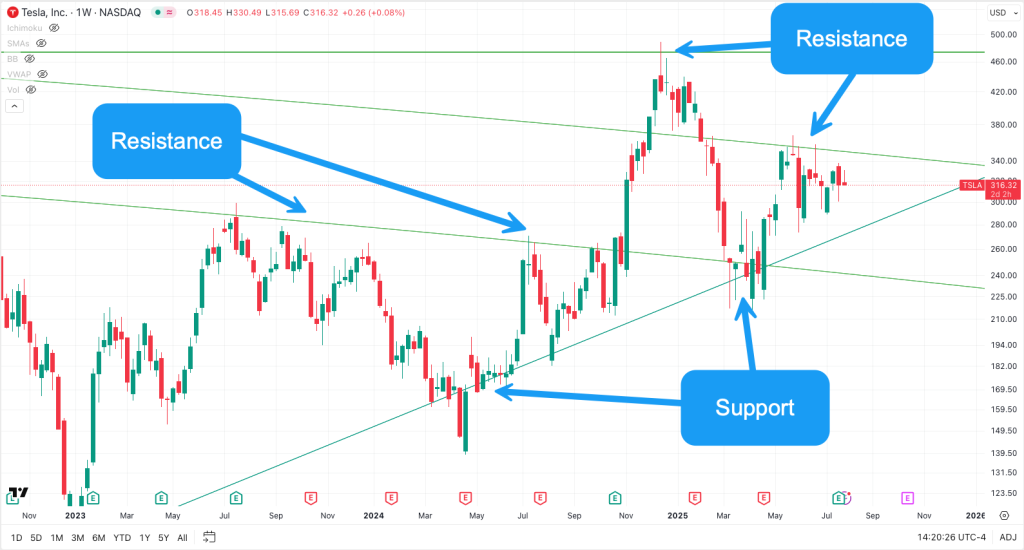
Download the Blueprint on Skool
If you don’t have a copy yet, consider downloading my free 6 Month Blueprint. Find Blueprints and free courses in our Skool Community
It’s true that diving into stock trading can feel intimidating, especially with all the charts, unfamiliar terms, and unpredictable swings.
But here’s the good news: you don’t have to navigate this alone or take on huge risks to get started. With the right approach, you can build confidence and see real results, just like I have.
In this guide, I’ll walk you through a beginner-friendly momentum trading strategy that’s simple, effective, and perfect for busy schedules. Inspired by my comprehensive online course, which distills years of my trading experience into practical steps, you’ll learn how to focus on patience, manage risk, and grow wealth steadily.
Whether you’re aiming for long-term gains or just starting out, this method flips the script on common pitfalls like buying high and selling low. Let’s review how it works and get you on the path to success!
The Simple Strategy That Delivered My 84%+ Gains in 5 Months – And How You Can Copy It
Step 1: Understand the Basics of Stock Trading and Why Momentum Trading Works for Beginners
Before jumping in, grasp what stock trading really is: buying shares of companies at a low price and selling them higher, based on patterns and momentum rather than guesswork or gambling.
Momentum trading is ideal for beginners because it focuses on stocks already showing upward movement—you’re not predicting the future but riding existing trends.
How the Momentum Strategy Works
Momentum trading is about identifying stocks in a strong uptrend and entering at smart, low-risk points. Here’s the breakdown:
- Spot the Opportunity: Scan for stocks making higher highs and higher lows on daily or weekly charts. This indicates buyer momentum where demand exceeds supply. Avoid downtrends or sideways markets—stick to bullish patterns.
- Buy Smart: Only enter at support zones (price levels where the stock has bounced before, like a “floor”). Use tools for confirmation:
- Ichimoku Cloud for overall trend strength.
- Moving averages (e.g., 50-day) to identify pullbacks.
- Fibonacci retracements (focus on levels like 0.786 for healthy dips).
- Gann Squares for price symmetry.
- Ride and Accumulate: Hold as the stock climbs, adding shares during minor pullbacks at new support levels. This “dollar-cost averaging up” builds positions over weeks or months. For more activity, trade shorter swings, but the core is patient riding of volatility in uptrends.
- Exit Wisely: Sell when momentum fades—watch for broken support, flat indicators, or “change of character” (e.g., lower highs). Take partial profits to lock in gains and recycle capital.
Why does this work? It leverages probabilities and avoids emotional pitfalls like fear of missing out (FOMO) or overtrading. Retail traders often lose by chasing highs, but this strategy emphasizes buying low in uptrends. Real results, like 65%+ gains in 4 months, show its potential, though trading involves risks and no guarantees.

My gains after just the first 5 months with this strategy:
Find all my trading challenge portfolio updates here.
| Ticker | Allocation % | Average Cost ($) | Closing Price ($) | % Gain |
|---|---|---|---|---|
| Individual Stocks | ||||
| TSLA | 10% | 244.30 | 333.87 | 36.66% |
| TIGR | 6% | 8.45 | 12.50 | 47.93% |
| EOSE | 4% | 4.63 | 6.90 | 49.03% |
| DUOL | 4% | 409.16 | 297.86 | -27.20% |
| NET | 4% | 191.71 | 208.71 | 8.87% |
| SHOP | 3% | 140.88 | 141.28 | 0.28% |
| SOFI | 3% | 23.49 | 25.54 | 8.73% |
| Crypto Related Stocks | ||||
| COIN | 10% | 191.95 | 304.54 | 58.63% |
| HOOD | 10% | 52.47 | 104.03 | 98.24% |
| ETHU | 5% | 61.91 | 146.75 | 137.06% |
| ETHA | 5% | 18.88 | 32.82 | 73.83% |
| MSTR | 6% | 367.64 | 334.41 | -9.04% |
| MSTU | 3% | 7.46 | 5.27 | -29.36% |
| Bitcoin Miners | ||||
| IREN | 10% | 9.92 | 26.48 | 166.94% |
| MARA | 7% | 14.07 | 15.98 | 13.57% |
| CLSK | 6% | 8.55 | 9.47 | 10.76% |
| CIFR | 5% | 2.89 | 7.64 | 164.36% |
| HIVE | 4% | 1.63 | 2.95 | 80.98% |
| RIOT | 4% | 7.30 | 13.76 | 88.49% |
| BTDR | 2% | 9.56 | 14.29 | 49.48% |
| Stocks That Look to Have Bottomed | ||||
| ENPH | 1% | 45.78 | 37.70 | -17.65% |
Avoid the #1 Mistake Beginners Make: Stop Buying High and Start Riding Momentum
Step 2: Set Up Your Trading Tools and Environment
You can’t trade without the right setup. Start by choosing a reliable brokerage like Charles Schwab for easy access to stocks. Then, get charting software—TradingView is free and powerful for beginners.
Practice is key: Use paper trading (simulated trades) to test without real money. Focus on building habits like journaling your trades to track emotions and decisions.

Why Momentum Trading Beats Day Trading for Busy Beginners (No Constant Screen Time Needed)
Step 3: Learn Technical Analysis for Spotting High-Probability Trades
Now, build the skills to analyze charts. Key concepts include:
- Market Structure: Identify uptrends and “change of character” (CHOCH) moments.
- Support and Resistance: These are your entry/exit zones—buy at support, sell at resistance.
- Tools in Action:
- Ichimoku Cloud: Confirms trends.
- Moving Averages: Spot uptrends with the 50 SMA.
- Fibonacci Retracement: Levels like 0.786/0.886 signal potential all-time highs if broken.
- Gann Squares: Add symmetry to your analysis.
The goal? Find confluence for confident buys.

Unlock High-Probability Trades: The Tools That Spot Winners Before They Explode
Step 4: Execute Trades with Discipline and Risk Management
Theory meets action: Build a watchlist using TradingView’s screener for uptrending stocks. Only buy at support with confluence. Scale in gradually (1-3% entries) during pullbacks, and exit partially at resistance if desired.
Follow these 5 golden rules:
- Stick to the strategy.
- Never chase prices.
- Limit position sizes.
- Buy support only—never resistance.
- Stay uncomfortable (buy on red days for better entries).
From Overwhelmed to Confident: Master Your Mindset and Crush Emotional Trading Pitfalls
Step 5: Master Your Mindset to Avoid Common Pitfalls
Trading is 80% mental. Emotions like FOMO or panic can derail even the best strategy. Draw from books like Trading in the Zone by Mark Douglas: Accept market chaos, think in probabilities, detach from outcomes, and start small.
Common mistakes to avoid:
- Chasing breakouts.
- Overtrading.
- Ignoring risk rules.
- Abandoning the plan.
- Buying high/selling low.
- Lacking patience.
Journaling and routines build resilience.
Final Thoughts: Start Your Trading Journey Today
You’ve now got a clear path to start stock trading as a beginner using a proven momentum strategy. Remember the core: Buy only at support, accumulate patiently, manage risk (1-3% per trade, max 10% per stock), and embrace volatility.
If you’re interested in learning more, the course interconnects everything—technicals, execution, and mindset—for real results. Learn more about it in our Skool group.
Trading is a skill honed through practice, so enroll in the group to access modules, community support, and tools.
Experience is the best teacher: Watch stocks over time, and you’ll see how this works.
Stay disciplined, learn from mistakes, and build wealth steadily. Join our free Skool community today to connect with other traders, share your progress, and learn more about mastering this momentum trading strategy!
Happy trading—results aren’t guaranteed, but with this approach, you’re set up for success!
Frequently Asked Questions (FAQs) About Stock Trading for Beginners
How much money do I need to start stock trading?
You can start with as little as $100-$500 in a brokerage account, but focus on learning with paper trading first to avoid risks.
What’s the difference between momentum trading and day trading?
Momentum trading involves holding positions for days to months in uptrends, while day trading requires constant monitoring and closing trades same-day—momentum is less stressful for beginners.
Is stock trading safe in 2025’s market?
No investment is completely safe; markets are volatile with potential for losses. Use risk management and educate yourself to minimize downsides.
How do I avoid the market noise?
Stick to your strategy, journal trades, and limit news intake—focus on charts and confluence signals.
Can I trade stocks part-time?
Yes! This momentum strategy is designed for busy lives, requiring only periodic check-ins rather than full-time attention.


